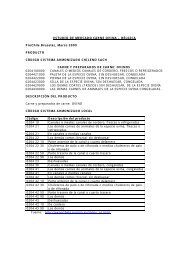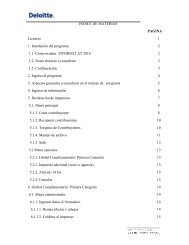Divestitures and carve-outs in the oil and gas industry - Deloitte
Divestitures and carve-outs in the oil and gas industry - Deloitte
Divestitures and carve-outs in the oil and gas industry - Deloitte
Create successful ePaper yourself
Turn your PDF publications into a flip-book with our unique Google optimized e-Paper software.
Position<strong>in</strong>g for survival <strong>and</strong> opportunity<br />
<strong>Divestitures</strong> <strong>and</strong> <strong>carve</strong>-<strong>outs</strong> <strong>in</strong> <strong>the</strong> <strong>oil</strong> <strong>and</strong><br />
<strong>gas</strong> <strong>in</strong>dustry<br />
Whatever <strong>the</strong><br />
situation, companies<br />
consider<strong>in</strong>g a<br />
divestiture or <strong>carve</strong>out<br />
can benefit from<br />
consider<strong>in</strong>g a number<br />
of key issues<br />
An uptick <strong>in</strong> M&A activity <strong>in</strong> late 2009 suggests to us that reposition<strong>in</strong>g has become <strong>the</strong><br />
watchword for a grow<strong>in</strong>g number of companies <strong>in</strong> <strong>oil</strong> <strong>and</strong> <strong>gas</strong> <strong>and</strong> related bus<strong>in</strong>esses.<br />
Several <strong>in</strong>tegrated mult<strong>in</strong>ational <strong>oil</strong> companies have announced <strong>the</strong>ir <strong>in</strong>tent to divest<br />
bus<strong>in</strong>esses <strong>and</strong> assets to redirect capital spend<strong>in</strong>g toward exploration <strong>and</strong> production.<br />
Some <strong>in</strong>dependent <strong>oil</strong> <strong>and</strong> <strong>gas</strong> companies have announced <strong>the</strong>ir <strong>in</strong>tent to sell noncore<br />
domestic, <strong>in</strong>ternational, <strong>and</strong> offshore portfolios to streaml<strong>in</strong>e <strong>the</strong>ir operations, <strong>and</strong> several<br />
<strong>oil</strong>field service companies have announced plans to exit certa<strong>in</strong> bus<strong>in</strong>ess l<strong>in</strong>es or countries.<br />
Such companies are shedd<strong>in</strong>g assets <strong>and</strong> carv<strong>in</strong>g out parts of <strong>the</strong>ir bus<strong>in</strong>ess for a variety of<br />
reasons. Strong cash flows from ris<strong>in</strong>g prices <strong>and</strong> dem<strong>and</strong> for services over <strong>the</strong> past several<br />
years have caused many companies to exp<strong>and</strong> <strong>in</strong> all directions. Now, pric<strong>in</strong>g pressures are<br />
forc<strong>in</strong>g some to reth<strong>in</strong>k <strong>the</strong>se expansive strategies as revenue falls. Tight credit conditions<br />
are chok<strong>in</strong>g off capital needed to operate <strong>and</strong> exp<strong>and</strong>. Technology advances are offer<strong>in</strong>g<br />
new exploration horizons for companies ready <strong>and</strong> able to pursue high-potential but<br />
expensive plays. Anticipated carbon <strong>and</strong> renewable energy legislation is dampen<strong>in</strong>g <strong>the</strong><br />
strategic view of ref<strong>in</strong><strong>in</strong>g, process<strong>in</strong>g <strong>and</strong> o<strong>the</strong>r bus<strong>in</strong>esses.<br />
Will<strong>in</strong>g buyers, <strong>in</strong>clud<strong>in</strong>g private equity <strong>in</strong>vestors, are show<strong>in</strong>g strong <strong>in</strong>terest. However,<br />
sellers may f<strong>in</strong>d it challeng<strong>in</strong>g <strong>in</strong> this environment to offload bus<strong>in</strong>esses with heavy capital<br />
dem<strong>and</strong>s, <strong>in</strong> volatile markets or fac<strong>in</strong>g significant structural changes as a result of new<br />
rules <strong>and</strong> regulations.<br />
Whatever <strong>the</strong> situation, companies consider<strong>in</strong>g a divestiture or <strong>carve</strong>-out can benefit from<br />
consider<strong>in</strong>g a number of key issues likely to arise as <strong>the</strong> transaction progresses, as well as<br />
effective practices for deal plann<strong>in</strong>g <strong>and</strong> execution.<br />
M&A Industry Advantage Series<br />
Oil & Gas
2<br />
Areas of <strong>in</strong>terest to buyers<br />
One of many f<strong>in</strong>ancial account<strong>in</strong>g issues that frequently will arise <strong>in</strong> a <strong>carve</strong>-out<br />
is treatment of corporate allocations. This will vary depend<strong>in</strong>g on <strong>the</strong> traditional<br />
structure of <strong>the</strong> seller. For example, a seller may choose to leave allocations, such as<br />
human resources, account<strong>in</strong>g, <strong>and</strong> treasury, <strong>in</strong> <strong>the</strong> reported f<strong>in</strong>ancial results because<br />
<strong>the</strong>y may be representative of <strong>the</strong> actual st<strong>and</strong>alone costs for those functions<br />
prospectively. O<strong>the</strong>r times, <strong>the</strong> seller may feel that <strong>the</strong> f<strong>in</strong>ancial picture may be more<br />
mean<strong>in</strong>gful by remov<strong>in</strong>g <strong>the</strong> allocation amounts <strong>and</strong> disclos<strong>in</strong>g to <strong>the</strong> buyer <strong>the</strong><br />
types of functions that are not <strong>in</strong>cluded <strong>in</strong> <strong>the</strong> bus<strong>in</strong>ess.<br />
To be well prepared for when prospective buyers knock at your door, consider <strong>the</strong><br />
follow<strong>in</strong>g account<strong>in</strong>g <strong>in</strong>formation that buyers generally want to see:<br />
• Transfer pric<strong>in</strong>g<br />
• Intercompany receivables <strong>and</strong> payables<br />
• Shared services <strong>and</strong> corporate allocations.<br />
• Acquisitions <strong>and</strong> divestitures<br />
• Restructur<strong>in</strong>g reserves<br />
• Capital spend<strong>in</strong>g, dry hole costs <strong>and</strong> asset impairments<br />
• Foreign exchange<br />
• Derivative f<strong>in</strong>ancial <strong>in</strong>struments<br />
• Pensions <strong>and</strong> post-retirement benefits<br />
• Self <strong>in</strong>surance experience <strong>and</strong> payments to captive <strong>in</strong>surance companies<br />
• Stock options <strong>and</strong> deferred compensation<br />
A major consideration <strong>in</strong> <strong>the</strong> complexity of a <strong>carve</strong>-out is <strong>the</strong> impact of <strong>in</strong>ternational<br />
activities. International operations – which often <strong>in</strong>clude a mix of <strong>carve</strong>-out <strong>and</strong><br />
legal entity sales (e.g., stock deals) – tend to be more complicated <strong>and</strong> require<br />
focused effort on <strong>the</strong> part of buyer <strong>and</strong> seller. In countries where a company has<br />
a smaller footpr<strong>in</strong>t, <strong>the</strong> bus<strong>in</strong>ess may not have sufficient post-divestiture scale<br />
to operate on a st<strong>and</strong>alone basis <strong>and</strong> a buyer may need to consider a different<br />
approach to operat<strong>in</strong>g <strong>in</strong> that locale. It is important that both parties underst<strong>and</strong><br />
country-specific requirements <strong>and</strong> work with local country operational <strong>and</strong> tax<br />
specialists <strong>and</strong> personnel. Also, <strong>the</strong> buyer will need certa<strong>in</strong> <strong>in</strong>formation, such as<br />
details around operat<strong>in</strong>g <strong>and</strong> payroll tax compliance to support un<strong>in</strong>terrupted postacquisition<br />
tax plann<strong>in</strong>g <strong>and</strong> report<strong>in</strong>g.<br />
M&A Industry Advantage Series — <strong>Divestitures</strong> <strong>and</strong> <strong>carve</strong>-<strong>outs</strong> <strong>in</strong> <strong>the</strong> <strong>oil</strong> <strong>and</strong> <strong>gas</strong> <strong>in</strong>dustry<br />
Decid<strong>in</strong>g what to sell <strong>and</strong> at what price<br />
In some cases, such as a strategic realignment, <strong>the</strong><br />
process of choos<strong>in</strong>g what to dispose of can be fairly<br />
straightforward. Assets that no longer fit with your<br />
company’s core bus<strong>in</strong>ess become prime c<strong>and</strong>idates.<br />
O<strong>the</strong>r factors can play an important role when decisions<br />
are not so clear cut; for example, when cost conta<strong>in</strong>ment<br />
is <strong>the</strong> prime motivation. In such cases, you may want to<br />
prioritize assets for disposition based on factors such as<br />
<strong>the</strong> growth potential, capital requirements, <strong>in</strong>dustry realignment<br />
issues <strong>and</strong> o<strong>the</strong>r risk considerations.<br />
Also view <strong>the</strong> assets you are consider<strong>in</strong>g for sale from <strong>the</strong><br />
perspective of potential buyers. Which assets are likely to<br />
be most attractive to <strong>the</strong>m?<br />
F<strong>in</strong>ally, determ<strong>in</strong>e how valuable <strong>the</strong> assets are to you.<br />
What is your walk-away price?
Identify<strong>in</strong>g <strong>the</strong> bus<strong>in</strong>ess early <strong>in</strong> <strong>the</strong> process<br />
It’s not unusual for a company to embark on a divestiture<br />
without completely underst<strong>and</strong><strong>in</strong>g or def<strong>in</strong><strong>in</strong>g what<br />
is actually be<strong>in</strong>g sold. What activities <strong>and</strong> services are<br />
<strong>in</strong>volved? Which people will be go<strong>in</strong>g with <strong>the</strong> bus<strong>in</strong>ess?<br />
What property, equipment, <strong>and</strong> plants will pass on to <strong>the</strong><br />
buyer?<br />
Sometimes sort<strong>in</strong>g out <strong>the</strong> bus<strong>in</strong>ess activities, people,<br />
<strong>and</strong> physical property – isn’t so easy. For an <strong>in</strong>tegrated<br />
operation, identify<strong>in</strong>g where <strong>and</strong> how to separate<br />
<strong>the</strong> bus<strong>in</strong>ess can <strong>in</strong>volve a number of challenges as<br />
product flows from <strong>the</strong> wellhead through pipel<strong>in</strong>e <strong>and</strong><br />
transportation systems to process<strong>in</strong>g, ref<strong>in</strong><strong>in</strong>g, market<strong>in</strong>g,<br />
<strong>and</strong> distribution organizations before ultimately be<strong>in</strong>g sold<br />
to a third-party customer. International bus<strong>in</strong>esses can<br />
be particularly tricky when <strong>the</strong> bus<strong>in</strong>ess relies heavily on<br />
shared services <strong>in</strong> each country with<strong>in</strong> which it operates<br />
<strong>and</strong> with differ<strong>in</strong>g levels of support depend<strong>in</strong>g upon <strong>the</strong><br />
scale of <strong>the</strong> bus<strong>in</strong>ess <strong>and</strong> <strong>the</strong> parent company <strong>in</strong> each<br />
country. Operations typically <strong>in</strong>volve an array of personnel<br />
that need to be considered for <strong>in</strong>clusion <strong>in</strong>clud<strong>in</strong>g<br />
eng<strong>in</strong>eers, geologists, field personnel, operations, safety,<br />
area managers <strong>and</strong> back office support.<br />
All of <strong>the</strong>se issues should be addressed from an operational<br />
st<strong>and</strong>po<strong>in</strong>t, as well as <strong>in</strong> f<strong>in</strong>ancial terms (see sidebar, “Areas<br />
of <strong>in</strong>terest to buyers”). Provid<strong>in</strong>g a potential buyer with<br />
an accurate picture of <strong>the</strong> account<strong>in</strong>g, tax, <strong>and</strong> f<strong>in</strong>ancial<br />
dimensions of <strong>the</strong> deal will h<strong>in</strong>ge on hav<strong>in</strong>g a clear view of<br />
<strong>the</strong> bus<strong>in</strong>ess.<br />
Conduct<strong>in</strong>g “sell-side due diligence”<br />
A seller’s credibility <strong>in</strong> a divestiture or <strong>carve</strong>-out can<br />
translate directly <strong>in</strong>to higher or lower deal value. The fewer<br />
<strong>the</strong> uncerta<strong>in</strong>ties about <strong>the</strong> accuracy <strong>and</strong> reliability of<br />
<strong>in</strong>formation be<strong>in</strong>g provided, <strong>the</strong> more will<strong>in</strong>g <strong>the</strong> buyer will<br />
be to pay full consideration, or a premium.<br />
Seller credibility is never higher than when <strong>the</strong> buyer first<br />
receives <strong>in</strong>formation on what’s be<strong>in</strong>g offered for sale. From<br />
<strong>the</strong>n on, any discrepancy or o<strong>the</strong>r unpleasant surprise<br />
uncovered through buyer due diligence will likely reduce<br />
that credibility <strong>and</strong>, as a consequence, <strong>the</strong> buyer’s trust<br />
<strong>and</strong> will<strong>in</strong>gness to pay what <strong>the</strong> seller is expect<strong>in</strong>g.<br />
Time is money <strong>in</strong> a divestiture.<br />
Company leaders are eager to<br />
complete <strong>the</strong> deal to realize <strong>the</strong><br />
anticipated f<strong>in</strong>ancial benefits, as<br />
well as control <strong>the</strong> cost of <strong>the</strong><br />
bankers, lawyers, <strong>and</strong> accountants<br />
that support <strong>the</strong> transaction<br />
M&A Industry Advantage Series — <strong>Divestitures</strong> <strong>and</strong> <strong>carve</strong>-<strong>outs</strong> <strong>in</strong> <strong>the</strong> <strong>oil</strong> <strong>and</strong> <strong>gas</strong> <strong>in</strong>dustry 3
4<br />
Therefore, it’s imperative that you prevent surprises from<br />
occurr<strong>in</strong>g down <strong>the</strong> l<strong>in</strong>e. To do that, you must have<br />
confidence <strong>in</strong> <strong>the</strong> <strong>in</strong>formation you’re provid<strong>in</strong>g from <strong>the</strong><br />
very start. The revenues, costs, <strong>and</strong> profits, <strong>and</strong> bus<strong>in</strong>ess<br />
description you <strong>in</strong>itially provide — likely at a summary level<br />
— must hold up throughout <strong>the</strong> buyer’s exam<strong>in</strong>ation of<br />
<strong>the</strong> operation.<br />
It’s also important to have ready explanations for unusual<br />
events or <strong>in</strong>cidents, such as a temporary bus<strong>in</strong>ess<br />
<strong>in</strong>terruption, customer issue, or event at an affiliated<br />
bus<strong>in</strong>ess that caused a negative f<strong>in</strong>ancial impact. Your<br />
management team should be able to provide an accurate<br />
account of what happened <strong>and</strong> how it was resolved.<br />
The bus<strong>in</strong>ess identified for disposition may have many<br />
<strong>in</strong>terdependencies, common customers, <strong>and</strong> o<strong>the</strong>r<br />
relationships with <strong>the</strong> bus<strong>in</strong>esses be<strong>in</strong>g reta<strong>in</strong>ed by <strong>the</strong><br />
seller. It is important to have a clear view of how <strong>the</strong>se<br />
relationships have <strong>in</strong>fluenced <strong>the</strong> bus<strong>in</strong>ess operations,<br />
procurement <strong>and</strong> market<strong>in</strong>g, profitability, <strong>and</strong> cash flows of<br />
<strong>the</strong> bus<strong>in</strong>ess <strong>and</strong> how those may change post-separation.<br />
Conduct<strong>in</strong>g “sell-side diligence” before <strong>the</strong> sales process<br />
starts can help you anticipate issues a buyer may raise<br />
<strong>and</strong> develop responses that help re<strong>in</strong>force your credibility<br />
(see sidebar, “Key focus areas of sell-side due diligence”).<br />
Location of tax basis <strong>and</strong> structural nuances can assist<br />
<strong>in</strong> tax plann<strong>in</strong>g to help maximize after-tax proceeds.<br />
And it can help you better underst<strong>and</strong> <strong>the</strong> impact of <strong>the</strong><br />
transaction on <strong>the</strong> parts of your bus<strong>in</strong>ess you’re not sell<strong>in</strong>g.<br />
Structur<strong>in</strong>g <strong>the</strong> transaction<br />
F<strong>in</strong>d<strong>in</strong>g common ground <strong>in</strong> deal pric<strong>in</strong>g is an ongo<strong>in</strong>g<br />
challenge for buyers <strong>and</strong> sellers. Periods of economic<br />
weakness <strong>in</strong>tensify <strong>the</strong> challenge, as bid/ask spreads<br />
tend to exp<strong>and</strong> <strong>and</strong> buyers hold <strong>the</strong> upper h<strong>and</strong> <strong>in</strong><br />
deal negotiations. Earn<strong>outs</strong> <strong>and</strong> o<strong>the</strong>r purchase price<br />
cont<strong>in</strong>gency adjustments may be used to help close <strong>the</strong><br />
buyer/seller value gap.<br />
M&A Industry Advantage Series — <strong>Divestitures</strong> <strong>and</strong> <strong>carve</strong>-<strong>outs</strong> <strong>in</strong> <strong>the</strong> <strong>oil</strong> <strong>and</strong> <strong>gas</strong> <strong>in</strong>dustry<br />
Earn<strong>outs</strong> can help sellers realize <strong>the</strong> value <strong>the</strong>y desire, <strong>and</strong><br />
help buyers manage <strong>the</strong>ir purchase price risk by shar<strong>in</strong>g<br />
some of that risk – <strong>and</strong> potential value realization – with<br />
<strong>the</strong> seller. In earnout arrangements, <strong>the</strong> buyer <strong>and</strong> seller<br />
agree to make a portion of <strong>the</strong> purchase price cont<strong>in</strong>gent<br />
upon <strong>the</strong> target company, subsidiary or division meet<strong>in</strong>g<br />
certa<strong>in</strong> future performance targets post-clos<strong>in</strong>g. O<strong>the</strong>r<br />
cont<strong>in</strong>gency adjustments may deal with risks <strong>in</strong> a specific<br />
set of contracts or o<strong>the</strong>r specific bus<strong>in</strong>ess issue <strong>and</strong> may be<br />
tied directly to <strong>the</strong> settlement of that issue.<br />
One of <strong>the</strong> first questions that sellers struggle with <strong>in</strong><br />
structur<strong>in</strong>g an earnout feature <strong>in</strong> a transaction is what<br />
<strong>the</strong> purchase price will be for <strong>the</strong> risk of <strong>the</strong> cont<strong>in</strong>gent<br />
arrangement. Agree<strong>in</strong>g to <strong>the</strong> appropriate performance<br />
targets or milestones is <strong>the</strong> most time consum<strong>in</strong>g part<br />
of earnout negotiations, as it establishes <strong>the</strong> basis for<br />
determ<strong>in</strong><strong>in</strong>g whe<strong>the</strong>r <strong>and</strong> under what circumstances<br />
<strong>the</strong> cont<strong>in</strong>gency may be <strong>in</strong> <strong>the</strong> money post-clos<strong>in</strong>g. Not<br />
def<strong>in</strong><strong>in</strong>g <strong>the</strong> performance targets <strong>in</strong> detail is one of <strong>the</strong><br />
most common causes of post-clos<strong>in</strong>g disputes.
Key focus areas of sell-side due diligence<br />
• Underst<strong>and</strong> <strong>in</strong>tra-company transactions, allocated costs, shared services, <strong>and</strong><br />
your plans for provid<strong>in</strong>g support post-acquisition <strong>and</strong> dur<strong>in</strong>g transition.<br />
• Evaluate <strong>the</strong> quality of earn<strong>in</strong>gs <strong>and</strong> identify “non-recurr<strong>in</strong>g” items for which<br />
management may want to consider adjust<strong>in</strong>g <strong>the</strong> f<strong>in</strong>ancial <strong>in</strong>formation.<br />
• Analyze <strong>the</strong> trend of work<strong>in</strong>g capital required by <strong>the</strong> <strong>carve</strong>-out bus<strong>in</strong>ess <strong>in</strong> order<br />
to develop a target work<strong>in</strong>g capital amount <strong>and</strong> mechanism <strong>in</strong> <strong>the</strong> purchase <strong>and</strong><br />
sale agreement.<br />
• Underst<strong>and</strong> <strong>the</strong> assumptions <strong>in</strong> your forecasts <strong>and</strong> <strong>the</strong> bridge of detailed data<br />
from actual results to forecast <strong>in</strong>formation.<br />
• Evaluate <strong>the</strong> cost structure for fixed versus variable costs, capital expenditure<br />
requirements, <strong>and</strong> <strong>the</strong> relevance of certa<strong>in</strong> general <strong>and</strong> adm<strong>in</strong>istrative activities<br />
to <strong>the</strong> <strong>carve</strong>-out bus<strong>in</strong>ess.<br />
• Underst<strong>and</strong> employee <strong>and</strong> union issues <strong>and</strong> related costs or exposures <strong>and</strong><br />
segregation of benefit plan liabilities <strong>and</strong> assets.<br />
• Identify all shared assets <strong>and</strong> facilities.<br />
• Gauge <strong>the</strong> ability to separate <strong>and</strong>/or cont<strong>in</strong>ue customer <strong>and</strong> supplier contracts<br />
<strong>and</strong> arrangements.<br />
• Estimate potential loss of <strong>in</strong>tercompany sales <strong>and</strong> o<strong>the</strong>r bus<strong>in</strong>ess secured by<br />
parent relationship.<br />
• Identify tax cont<strong>in</strong>gencies <strong>and</strong> ability to “push down” debt <strong>in</strong>to divested<br />
bus<strong>in</strong>esses.<br />
Execut<strong>in</strong>g <strong>the</strong> transition<br />
The speed with which divestitures <strong>and</strong> <strong>carve</strong>-<strong>outs</strong> take place can result <strong>in</strong> <strong>the</strong> buyer not<br />
hav<strong>in</strong>g <strong>the</strong> <strong>in</strong>frastructure necessary to take over operations quickly. In such cases <strong>the</strong><br />
buyer <strong>and</strong> seller can enter <strong>in</strong>to a transition services agreement, or TSA, <strong>in</strong> which <strong>the</strong> seller<br />
cont<strong>in</strong>ues to provide operational support for a period of time. Careful attention should<br />
be given to how <strong>the</strong> TSA will be structured <strong>and</strong> executed, as well as <strong>the</strong> conditions <strong>and</strong><br />
timetable for its dissolution. Performance metrics <strong>and</strong> “must have” timel<strong>in</strong>es are also<br />
critical components to any well-crafted TSA.<br />
Anticipat<strong>in</strong>g post-deal considerations<br />
Once you have sold off assets, how will you know whe<strong>the</strong>r you’ve realized <strong>the</strong> benefits<br />
you expected from <strong>the</strong> transaction? Give consideration to sett<strong>in</strong>g metrics <strong>and</strong> benchmarks<br />
for post-deal performance.<br />
M&A Industry Advantage Series — <strong>Divestitures</strong> <strong>and</strong> <strong>carve</strong>-<strong>outs</strong> <strong>in</strong> <strong>the</strong> <strong>oil</strong> <strong>and</strong> <strong>gas</strong> <strong>in</strong>dustry 5
6<br />
Employ<strong>in</strong>g effective practices<br />
Tak<strong>in</strong>g some key steps can help lay <strong>the</strong> foundation for deal<br />
success. Here are three suggestions to consider as you<br />
prepare a bus<strong>in</strong>ess for sale or a function for <strong>carve</strong>-out:<br />
Appo<strong>in</strong>t a full-time project champion <strong>outs</strong>ide of<br />
<strong>the</strong> bus<strong>in</strong>ess<br />
As noted above, carv<strong>in</strong>g out a portion of <strong>the</strong> enterprise<br />
to be sold will affect a variety of functional responsibilities<br />
<strong>and</strong> employee groups with<strong>in</strong> <strong>the</strong> organization. Because<br />
of <strong>the</strong> breadth <strong>and</strong> weight of issues that <strong>in</strong>evitably will<br />
arise, it is imperative that someone with sufficient stature<br />
<strong>and</strong> authority lead <strong>the</strong> process. The divestiture will require<br />
different parts of <strong>the</strong> company to work toge<strong>the</strong>r <strong>in</strong> new<br />
ways <strong>and</strong> <strong>in</strong> some cases buy <strong>in</strong>to decisions <strong>the</strong>y don’t view<br />
as be<strong>in</strong>g <strong>in</strong> <strong>the</strong>ir best <strong>in</strong>terest.<br />
The executive put <strong>in</strong> charge will usually be a member<br />
of <strong>the</strong> corporate team. He or she should have st<strong>and</strong><strong>in</strong>g<br />
<strong>and</strong> authority with<strong>in</strong> <strong>the</strong> company to effectively manage<br />
<strong>in</strong>evitable cross-functional conflicts. At <strong>the</strong> same time, <strong>the</strong><br />
transaction needs to have board-level support <strong>and</strong> clearly<br />
def<strong>in</strong>ed accountability for <strong>the</strong> board, CEO <strong>and</strong> executives <strong>in</strong><br />
charge of <strong>the</strong> deal. Prior to launch<strong>in</strong>g a divestiture strategy,<br />
leadership must clearly outl<strong>in</strong>e <strong>the</strong> overarch<strong>in</strong>g M&A<br />
strategy <strong>and</strong> communication plans to ma<strong>in</strong>ta<strong>in</strong> executive<br />
alignment.<br />
Focus on <strong>the</strong> people aspect of a <strong>carve</strong>-out<br />
Clearly def<strong>in</strong><strong>in</strong>g <strong>the</strong> separation strategy <strong>and</strong> how<br />
employees will be affected by <strong>the</strong> <strong>carve</strong>-out is complex.<br />
However, <strong>in</strong> order to ma<strong>in</strong>ta<strong>in</strong> momentum <strong>and</strong> effectively<br />
execute <strong>the</strong> transaction, <strong>the</strong> seller’s <strong>in</strong>ternal communication<br />
<strong>and</strong> people strategies should not be overlooked.<br />
While traditional divestitures can be somewhat<br />
straightforward when it comes to which employees<br />
rema<strong>in</strong> <strong>and</strong> which are transitioned with <strong>the</strong> divested<br />
organization, <strong>carve</strong>-<strong>outs</strong> are more complex. Uncerta<strong>in</strong>ty<br />
regard<strong>in</strong>g employees’ futures can significantly decrease<br />
productivity, so a clear view of <strong>the</strong> <strong>carve</strong>-out’s impact on<br />
<strong>the</strong> organization is critical to ma<strong>in</strong>ta<strong>in</strong><strong>in</strong>g bus<strong>in</strong>ess as usual.<br />
M&A Industry Advantage Series — <strong>Divestitures</strong> <strong>and</strong> <strong>carve</strong>-<strong>outs</strong> <strong>in</strong> <strong>the</strong> <strong>oil</strong> <strong>and</strong> <strong>gas</strong> <strong>in</strong>dustry<br />
Commit to precision <strong>and</strong> detailed follow-through<br />
on tasks<br />
Time is money <strong>in</strong> a divestiture. Company leaders are eager<br />
to complete <strong>the</strong> deal to realize <strong>the</strong> anticipated f<strong>in</strong>ancial<br />
benefits, as well as control <strong>the</strong> cost of <strong>the</strong> bankers, lawyers,<br />
<strong>and</strong> accountants that support <strong>the</strong> transaction.<br />
But shortcuts ultimately create more issues than <strong>the</strong>y solve.<br />
Tak<strong>in</strong>g <strong>the</strong> time to do th<strong>in</strong>gs right <strong>the</strong> first time can be<br />
difficult, but it is critical to hav<strong>in</strong>g a clean process <strong>and</strong> to<br />
ma<strong>in</strong>ta<strong>in</strong><strong>in</strong>g credibility with <strong>the</strong> buyer.<br />
For example, you should have a complete view of <strong>the</strong><br />
f<strong>in</strong>ancial <strong>in</strong>formation before disclos<strong>in</strong>g any data to a buyer.<br />
All of <strong>the</strong> historical f<strong>in</strong>ancial <strong>in</strong>formation that you’re go<strong>in</strong>g<br />
to provide should be ga<strong>the</strong>red, analyzed, <strong>and</strong> assembled<br />
<strong>in</strong> a data room at <strong>the</strong> <strong>outs</strong>et, even if you’re only go<strong>in</strong>g to<br />
provide a small portion of it to a broad group of potential<br />
buyers <strong>in</strong> <strong>the</strong> <strong>in</strong>itial steps of <strong>the</strong> transaction.<br />
You want to avoid shar<strong>in</strong>g <strong>in</strong>formation early that ends up<br />
be<strong>in</strong>g contradicted or contested later <strong>in</strong> a more detailed<br />
portion of <strong>the</strong> process. Be<strong>in</strong>g well prepared <strong>and</strong> spend<strong>in</strong>g<br />
<strong>the</strong> time <strong>and</strong> effort to have precise <strong>in</strong>formation upfront can<br />
translate <strong>in</strong>to credibility <strong>and</strong> value.
Underst<strong>and</strong><strong>in</strong>g <strong>the</strong> value of auditable <strong>carve</strong>-out f<strong>in</strong>ancial statements<br />
A buyer’s f<strong>in</strong>anc<strong>in</strong>g plans or disclosure requirements may compel <strong>the</strong> seller to develop full,<br />
audited f<strong>in</strong>ancial statements for <strong>the</strong> <strong>carve</strong>-out bus<strong>in</strong>ess. It’s important for both parties to<br />
underst<strong>and</strong> that <strong>the</strong> numbers <strong>in</strong>cluded <strong>in</strong> <strong>the</strong>se auditable statements may not – <strong>in</strong> fact,<br />
probably should not – agree with <strong>the</strong> numbers that come out of <strong>the</strong> due diligence process.<br />
Why? A number of account<strong>in</strong>g issues can arise <strong>in</strong> prepar<strong>in</strong>g <strong>the</strong> adjustments required for<br />
<strong>the</strong>se two different types of f<strong>in</strong>ancial statements, <strong>and</strong> <strong>the</strong>se need to be addressed <strong>in</strong> detail<br />
to substantiate <strong>the</strong> amounts subject to external audit. The seller should be able to provide<br />
statements that will reflect <strong>the</strong> account<strong>in</strong>g <strong>and</strong> disclosures necessary for an audit that<br />
o<strong>the</strong>rwise might be seen as a last m<strong>in</strong>ute surprise by a potential buyer.<br />
Achiev<strong>in</strong>g your deal goals<br />
Market dynamics <strong>and</strong> economic conditions are caus<strong>in</strong>g <strong>oil</strong> <strong>and</strong> <strong>gas</strong> <strong>and</strong> related midstream,<br />
downstream, <strong>and</strong> service companies to seize <strong>the</strong>ir most promis<strong>in</strong>g opportunities <strong>and</strong> rightsize<br />
<strong>the</strong>ir operations. This reposition<strong>in</strong>g often dictates <strong>the</strong> divestiture or <strong>carve</strong>-out of some<br />
exist<strong>in</strong>g operations. By consider<strong>in</strong>g <strong>the</strong> issues outl<strong>in</strong>ed above <strong>and</strong> adopt<strong>in</strong>g effective M&A<br />
practices, sellers can <strong>in</strong>crease <strong>the</strong> likelihood of achiev<strong>in</strong>g deal goals.<br />
M&A Industry Advantage Series — <strong>Divestitures</strong> <strong>and</strong> <strong>carve</strong>-<strong>outs</strong> <strong>in</strong> <strong>the</strong> <strong>oil</strong> <strong>and</strong> <strong>gas</strong> <strong>in</strong>dustry 7
Please visit <strong>the</strong> onl<strong>in</strong>e merger <strong>and</strong> acquisition<br />
library which showcases <strong>the</strong> best current<br />
th<strong>in</strong>k<strong>in</strong>g about mergers, acquisitions <strong>and</strong><br />
divestitures. If you’re look<strong>in</strong>g for guidance<br />
on how to tackle <strong>the</strong> toughest issues <strong>in</strong> M&A<br />
today, we th<strong>in</strong>k you’ll f<strong>in</strong>d this a great place to<br />
start. Visit us at www.deloitte.com/us/MAlibrary<br />
To receive a free subscription of <strong>the</strong> latest M&Arelated<br />
thoughtware, newsletter <strong>and</strong> events<br />
visit us at www.deloitte.com/us/MAsubscribe<br />
This publication conta<strong>in</strong>s general <strong>in</strong>formation only <strong>and</strong> is based on <strong>the</strong> experiences <strong>and</strong> research of <strong>Deloitte</strong> practitioners.<br />
<strong>Deloitte</strong> is not, by means of this publication, render<strong>in</strong>g bus<strong>in</strong>ess, f<strong>in</strong>ancial, <strong>in</strong>vestment, or o<strong>the</strong>r professional advice or<br />
services. This publication is not a substitute for such professional advice or services, nor should it be used as a basis for<br />
any decision or action that may affect your bus<strong>in</strong>ess. Before mak<strong>in</strong>g any decision or tak<strong>in</strong>g any action that may affect<br />
your bus<strong>in</strong>ess, you should consult a qualified professional advisor. <strong>Deloitte</strong>, its affiliates, <strong>and</strong> related entities shall not be<br />
responsible for any loss susta<strong>in</strong>ed by any person who relies on this publication.<br />
About <strong>Deloitte</strong><br />
<strong>Deloitte</strong> refers to one or more of <strong>Deloitte</strong> Touche Tohmatsu, a Swiss Vere<strong>in</strong>, <strong>and</strong> its network of member firms, each of<br />
which is a legally separate <strong>and</strong> <strong>in</strong>dependent entity. Please see www.deloitte.com/about for a detailed description of <strong>the</strong><br />
legal structure of <strong>Deloitte</strong> Touche Tohmatsu <strong>and</strong> its member firms. Please see www.deloitte.com/us/about for a detailed<br />
description of <strong>the</strong> legal structure of <strong>Deloitte</strong> LLP <strong>and</strong> its subsidiaries.<br />
Copyright © 2010 <strong>Deloitte</strong> Development LLC. All rights reserved.<br />
Member of <strong>Deloitte</strong> Touche Tohmatsu<br />
Contacts<br />
Jim Dillavou<br />
Partner<br />
<strong>Deloitte</strong> & Touche LLP<br />
+1 713 982 2137<br />
jdillavou@deloitte.com<br />
Jeff Walker<br />
Partner<br />
<strong>Deloitte</strong> Tax<br />
+1 713 982 4064<br />
jeffwalker@deloitte.com<br />
Jed Shreve<br />
Pr<strong>in</strong>cipal<br />
<strong>Deloitte</strong> F<strong>in</strong>ancial Advisory<br />
Services LLP<br />
+1 713 982 4393<br />
jshreve@deloitte.com<br />
Jeff Weirens<br />
Pr<strong>in</strong>cipal<br />
<strong>Deloitte</strong> Consult<strong>in</strong>g LLP<br />
+1 612 845 6747<br />
jweirens@deloitte.com<br />
Trevear Thomas<br />
Pr<strong>in</strong>cipal<br />
<strong>Deloitte</strong> Consult<strong>in</strong>g LLP<br />
+1 713 982 4761<br />
trethomas@deloitte.com<br />
Andy Wilson<br />
Partner<br />
<strong>Deloitte</strong> & Touche LLP<br />
+1 312 486 3587<br />
<strong>and</strong>wilson@deloitte.com

















